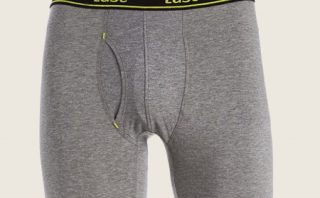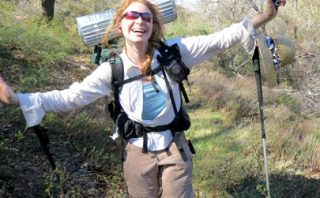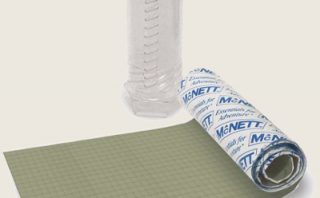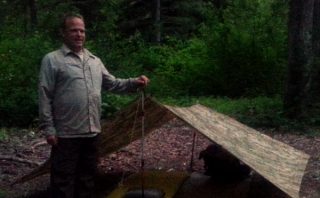Crawling into sleeping bags is a prized moment at the end of a long day on the trail. Puffy warmness over me and cushy softness under. Most nights we would have storytime – one of us would read out loud to the others (that way we only had to carry one book between the three of us). Maybe we would stay up to watch the stars. Usually we only managed to stay awake until the first ones appeared. Sleeping while hiking a long trail requires a whole system of sleeping gear, not just a sleeping bag.

Sleeping Bag
I like the idea behind sleeping quilts. Insulation compressed under you doesn’t provide any insulating warmth so only have your insulation above you like with a down comforter. But on cold nights with a quilt, you have to keep the sides tucked under you to keep drafts from chilling you. This doesn’t work so well for me since I tend to roll around a lot when I sleep.
So I carried a ZPacks 900 Fill Power Down Sleeping Bag. The bag has a 3/4 length zipper so you can leave the bag wide open on warm nights and zip up snug on cold ones. The bag also has a roomy foot box. I got a 20-degree bag, short length, and wide girth (at the shoulder), which weighs just over a pound at 17.2 oz.
The zipper is on the bottom of the bag so when you sleep it is underneath you. This makes it so drafts don’t come in through the zipper. The zipper is small and unobtrusive and I never had a problem feeling it underneath me.
The bag has an elastic draw cord at the neck so you can snug that up on cold nights. I never used it. In fact, the draw cord was sometimes annoying as it would occasionally rub against my neck. Maybe I should have cut it off.
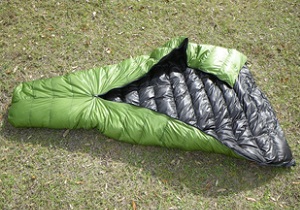
One technique I used for making sure I slept warm was to hold the bag horizontally by the zipper, one hand at the neck and the other by the foot box, and shake all the down into the top of the baffles. This ensured a maximum amount of down and loft was above insulating me as I slept.
Sleeping Clothes
In order to keep your sleeping bag clean and for extra warmth on extra cold nights, some people use a sleeping bag liner. I chose to use sleeping clothes, which were also my extra insulating layers except for my sleeping socks. Those are dedicated only for sleeping in. My sleeping socks were SmartWool Light Hiker Socks. I was going to bring an Ibex Woolies Long John Zip-T Top for layers and sleeping in, but left it at home because my clothes bag weighed too much. I had along a Marmot Driclime Windshirt that I used a few times for sleeping in. Mostly I just slept in my Ibex Woolies T-Shirt that I also wore during the day. So much for keeping the sleeping bag clean. I also sometimes wore my Ibex Woolies Long John Bottoms on cold nights and would also configure my Buff Wool Buff as a hat to wear at night.
The night we slept above the last lakes before Muir Pass in the Sierra Mountains was a very cold night. In the morning, frost covered everything and water bottles contained a little slush. That night, and nights like it, I used my puffy down jacket as an extra layer of insulation above my upper torso and around my neck. Nice trick.
Sleeping Pad
As Dances With Lizards would say, “Once you’ve slept on air, you’ll never go back.” Back to closed cell foam sleeping pads, that is. I tried to go back. It didn’t work out.

My sleeping pad is a Cascade Designs Therm-A-Rest NeoAir. I bought a size large to fit my shoulders. The size large is 25 x 77 inches, inflates to 2.5 inches, and weighs 19 oz. Since I’m not that tall, I trimmed 18″ off the bottom of it and ironed it back together. This also cut 3 oz of weight out of my pack. I like my NeoAir. I’ve never had problems with it getting punctured. And the crinkly sound some people complain about hasn’t bothered me. Maybe I’m too tired at the end of the day to care.
What I don’t like about my NeoAir is the time it takes to blow it up. But it’s something I just fit into my evening routine. Kind of make it my sleeping pad meditation. I also have been concerned about the placement of the valve stem. It sort of sits on top of the pad, which means when the mattress is rolled up there’s pressure against it. I’m thinking at some point this may cause a failure where the stem connects to the mattress. But this hasn’t happened yet. For 2012, Cascade Designs came out with the Therm-A-Rest NeoAir XLite Sleeping Pad and Therm-A-Rest NeoAir Xtherm replacing the rectangular, lime green ones like mine. On the new NeoAir, the valve stem is on the edge of the top of the mattress and doesn’t get pressure when rolled up (Dances With Lizards carried a NeoAir XLite and I checked).

When we got to Agua Dulce, 454 miles into our walk, I was racking my brains for ways to cut more weight out of my pack. Blaze was using a size small Cascade Designs Therm-A-Rest Ridgerest SOlite Sleeping Pad, which is 20 x 48 inches, 0.625 inches thick, and weighs 9 oz. If I used one of those, I would cut another half pound of weight out of my pack. I got a ride into REI in Northridge, CA from Hiker Heaven (Trail Angels Donna and Jeff Saufley) and bought one along with some other replacement gear.
Well, that wasn’t such a good decision. I didn’t find the pad very comfortable to sleep on, especially when compared to my NeoAir. I also didn’t like having my aching feet hanging off onto gear or the ground at night. I carried the pad rolled up and strapped to the top of my pack, so it was convenient to pull off for a sit pad and laying on during desert heat siestas. The special, silver aluminized surface for boosting warmth and reflecting heat back to your body quickly wore off. I was glad to get my NeoAir back at Kennedy Meadows where I had bounced it along with a bear canister. Dances With Lizards and I cut the RidgeRest in half and each took a piece as a sit pad.
My air mattress is heavy. I could definitely cut some weight out of my pack by changing it. I’m considering going with a Cascade Designs Therm-A-Rest NeoAir XLite on my next long trail. The small is 8 oz but also only 47 inches long, which I wouldn’t prefer because, like I said, I don’t sleep so well with my feet hanging off the end. The regular like Dances With Lizards carried is only 12 oz. This might be a good option. Especially if I can cut down the length and iron it back together. Cut even more weight that way. I wonder if anyone’s pioneered this? Not sure I want to be the first at whacking away at a $160 piece of gear. Luxury would be with a cut down large NeoAir XLite at 25 inches wide. But I just don’t think it would provide enough weight savings. The large NeoAir XLite starts out at 16 oz like what I already carry. Cutting 18 inches off the length might only save a couple ounces. I’d like to save six or eight ounces here.
Sleeping Pad Air Pump
I started the trail carrying an Exped Mini Pump for my air mattress. The pump required a little modification to get the valve connector to fit on my NeoAir (used my pocket knife to carve out a little of the plastic inside the connector). I ditched the pump and its 1.4 oz in a hiker box a week into the trip at the Kick Off. Pumping up my air mattress by hand and foot using the mini pump was slow. Much faster to use my own hot air and just blow the mattress up myself. As I blew up my NeoAir, I would end up laying under it. I told Blaze and Dances With Lizards how nice it would be to blow up a mattress that totally surrounded me when I was done – maybe like bubble wrapping myself. Made sense to me with most of my body aching after a long day of hiking.
Pillow
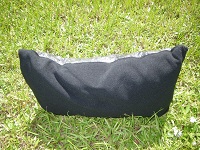
I chose not to carry the weight of a backpacking pillow. Instead, I went with the time honored technique of using the stuff sack with my extra clothes in it as my pillow. I see on Zpacks website that they have a new Pillow Dry Bag out. This dry bag is the same as the one that comes with their sleeping bag except it has micro fleece sewn to one half on the inside. Flip the dry bag inside out, stuff it with spare clothes, and use as a pillow. Sounds a lot nicer to have against my face than the silnylon of the stuff sack I’ve been using. I think I’ll be picking up one of these.
Ground Sheet
I initially carried a ground sheet on the trail. Mine was a piece of 54 x 90 inch Tyvek that I bought from Zpacks. I cut it down to 72 inches and it weighed 5.5 oz. I brought it along because I generally carry one and they have lots of uses: protect the air mattress when cowboy camping (sleeping under the stars); an emergency shelter; wrap someone up who is wet, cold, or hypothermic; put gear on it and keep stuff out of dirt or mud; etc.
I used my ground sheet a very few times for cowboy camping. I put it out for siestas for awhile so we wouldn’t have to take breaks in the dirt. And I would put my pack and gear on it in camp. But after a few weeks on the trail, I quit caring about whether I sat in the dirt, took breaks in the dirt, laid in the dirt, or put gear on the dirt. We also preferred to sleep in the tent screened off from bugs. I decided 5.5 oz of ground sheet was too much to carry for just a little use. I got rid of it. I was going to put it in a hiker box, but Blaze took it instead.


